2020 NISSAN ALTIMA park assist
[x] Cancel search: park assistPage 416 of 559
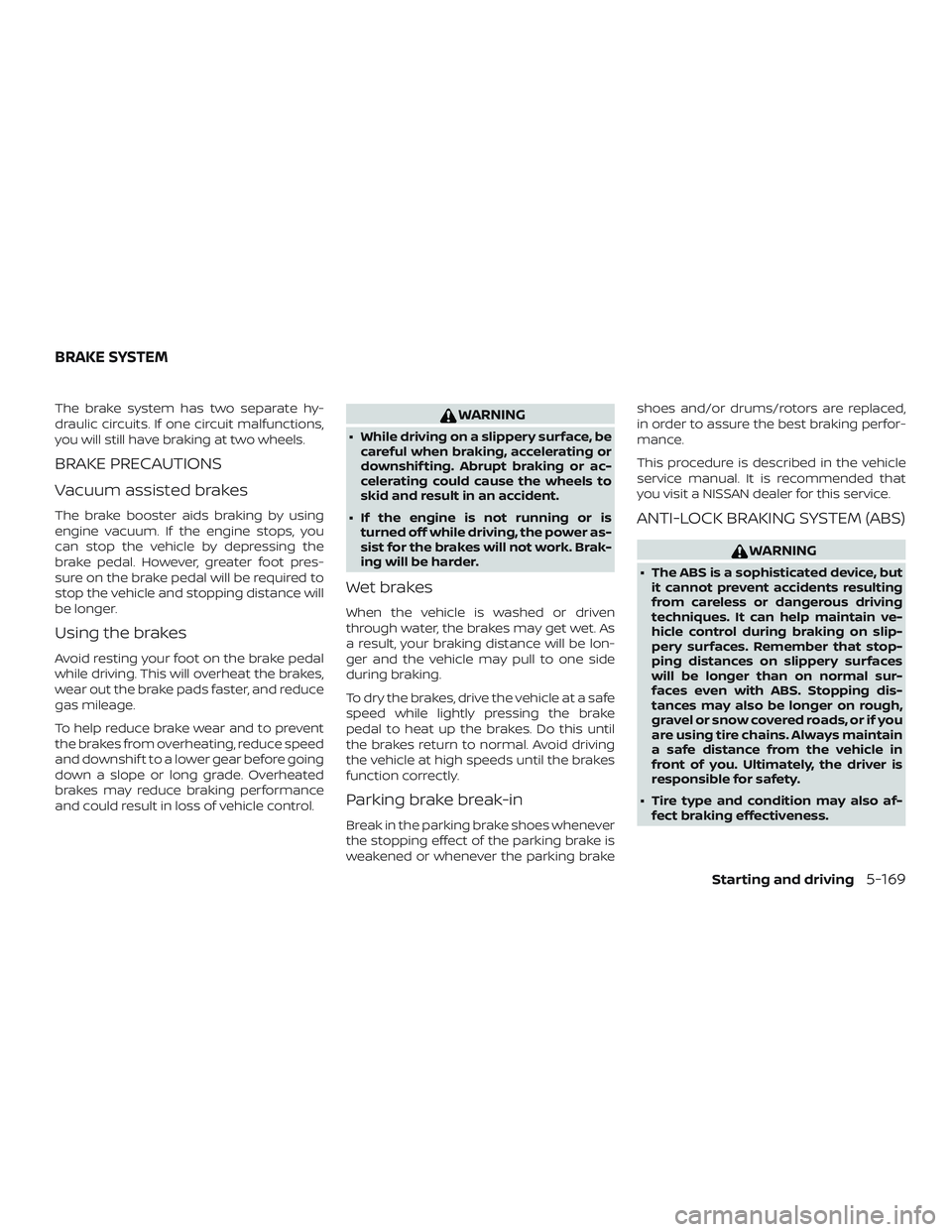
The brake system has two separate hy-
draulic circuits. If one circuit malfunctions,
you will still have braking at two wheels.
BRAKE PRECAUTIONS
Vacuum assisted brakes
The brake booster aids braking by using
engine vacuum. If the engine stops, you
can stop the vehicle by depressing the
brake pedal. However, greater foot pres-
sure on the brake pedal will be required to
stop the vehicle and stopping distance will
be longer.
Using the brakes
Avoid resting your foot on the brake pedal
while driving. This will overheat the brakes,
wear out the brake pads faster, and reduce
gas mileage.
To help reduce brake wear and to prevent
the brakes from overheating, reduce speed
and downshif t to a lower gear before going
down a slope or long grade. Overheated
brakes may reduce braking performance
and could result in loss of vehicle control.
WARNING
∙ While driving on a slippery surface, becareful when braking, accelerating or
downshif ting. Abrupt braking or ac-
celerating could cause the wheels to
skid and result in an accident.
∙ If the engine is not running or is turned off while driving, the power as-
sist for the brakes will not work. Brak-
ing will be harder.
Wet brakes
When the vehicle is washed or driven
through water, the brakes may get wet. As
a result, your braking distance will be lon-
ger and the vehicle may pull to one side
during braking.
To dry the brakes, drive the vehicle at a safe
speed while lightly pressing the brake
pedal to heat up the brakes. Do this until
the brakes return to normal. Avoid driving
the vehicle at high speeds until the brakes
function correctly.
Parking brake break-in
Break in the parking brake shoes whenever
the stopping effect of the parking brake is
weakened or whenever the parking brake shoes and/or drums/rotors are replaced,
in order to assure the best braking perfor-
mance.
This procedure is described in the vehicle
service manual. It is recommended that
you visit a NISSAN dealer for this service.
ANTI-LOCK BRAKING SYSTEM (ABS)
WARNING
∙ The ABS is a sophisticated device, but
it cannot prevent accidents resulting
from careless or dangerous driving
techniques. It can help maintain ve-
hicle control during braking on slip-
pery surfaces. Remember that stop-
ping distances on slippery surfaces
will be longer than on normal sur-
faces even with ABS. Stopping dis-
tances may also be longer on rough,
gravel or snow covered roads, or if you
are using tire chains. Always maintain
a safe distance from the vehicle in
front of you. Ultimately, the driver is
responsible for safety.
∙ Tire type and condition may also af- fect braking effectiveness.
BRAKE SYSTEM
Starting and driving5-169
Page 422 of 559

When the vehicle is stopped on a hill, the hill
start assist system automatically keeps
the brakes applied to help prevent the ve-
hicle from rolling backward in the time it
takes the driver to release the brake pedal
and apply the accelerator.
The hill start assist system will operate au-
tomatically under the following conditions:∙ The transmission is shif ted to a forward or reverse gear.
∙ The vehicle is stopped completely on a hill by applying the brake. The maxi-
mum holding time is 2 seconds. Af ter
2 seconds the vehicle will begin to roll
back and the hill start assist system will
stop operating completely.
The hill start assist system will not operate
when the shif t lever is placed in the N (Neu-
tral) or P (Park) position or on a flat and level
road. The RSS sounds a tone to inform the driver
of obstacles near the bumper.
When the “DISPLAY” key is on, the sonar
view will automatically appear in the
touch-screen display. An additional view of
the sonar status will appear in the vehicle
information display for reference.WARNING
∙ The RSS is a convenience but it is not a
substitute for proper parking.
∙ The driver is always responsible for safety during parking and other ma-
neuvers. Always look around and
check that it is safe to do so before
parking.
∙ Read and understand the limitations of the RSS as contained in this section.
The colors of the corner sonar indica-
tor and the distance guide lines in the
rear view indicate different distances
to the object.
∙ Inclement weather or ultrasonic sources such as an automatic car
wash, a truck’s compressed-air
brakes or a pneumatic drill may affect
the function of the system; this may
include reduced performance or a
false activation.
∙ This function is designed as an aid to the driver in detecting large station-
ary objects to help avoid damaging
the vehicle.
LSD3247
REAR SONAR SYSTEM (RSS) (if so
equipped)
Starting and driving5-175
Page 425 of 559
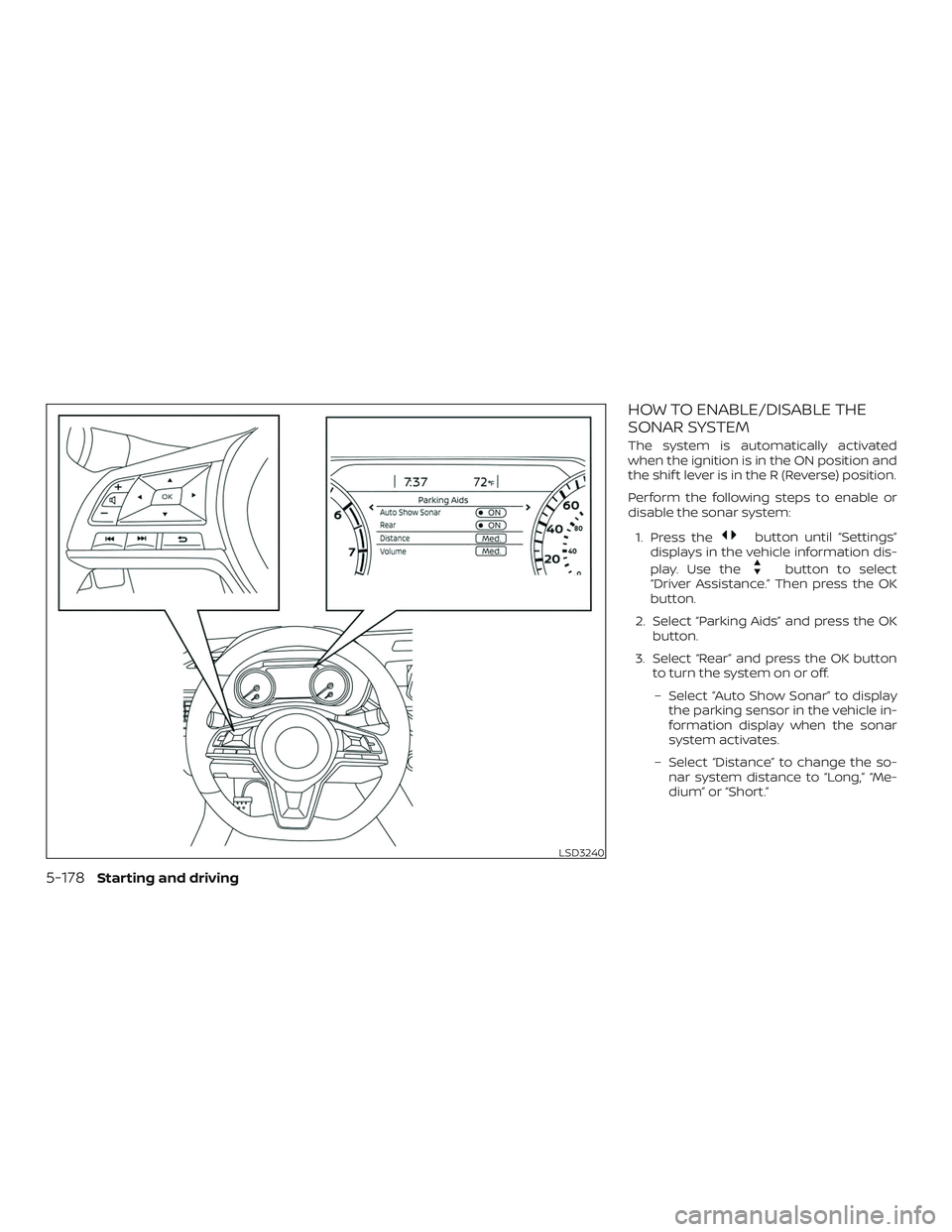
HOW TO ENABLE/DISABLE THE
SONAR SYSTEM
The system is automatically activated
when the ignition is in the ON position and
the shif t lever is in the R (Reverse) position.
Perform the following steps to enable or
disable the sonar system:1. Press the
button until “Settings”
displays in the vehicle information dis-
play. Use the
button to select
“Driver Assistance.” Then press the OK
button.
2. Select “Parking Aids” and press the OK button.
3. Select “Rear” and press the OK button to turn the system on or off.
– Select “Auto Show Sonar” to display the parking sensor in the vehicle in-
formation display when the sonar
system activates.
– Select “Distance” to change the so- nar system distance to “Long,” “Me-
dium” or “Short.”
LSD3240
5-178Starting and driving
Page 435 of 559
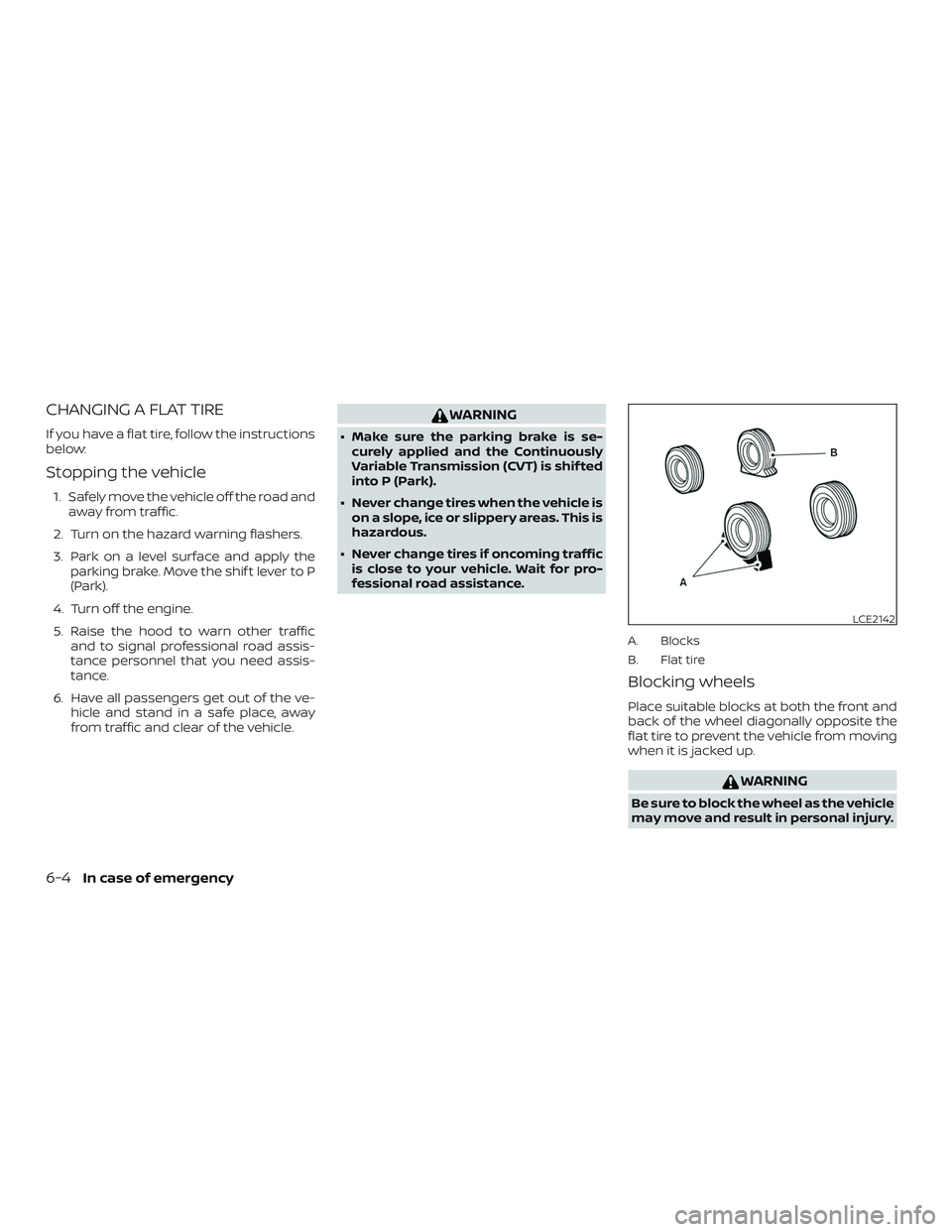
CHANGING A FLAT TIRE
If you have a flat tire, follow the instructions
below:
Stopping the vehicle
1. Safely move the vehicle off the road andaway from traffic.
2. Turn on the hazard warning flashers.
3. Park on a level surface and apply the parking brake. Move the shif t lever to P
(Park).
4. Turn off the engine.
5. Raise the hood to warn other traffic and to signal professional road assis-
tance personnel that you need assis-
tance.
6. Have all passengers get out of the ve- hicle and stand in a safe place, away
from traffic and clear of the vehicle.
WARNING
∙ Make sure the parking brake is se-curely applied and the Continuously
Variable Transmission (CVT) is shif ted
into P (Park).
∙ Never change tires when the vehicle is on a slope, ice or slippery areas. This is
hazardous.
∙ Never change tires if oncoming traffic is close to your vehicle. Wait for pro-
fessional road assistance.
A. Blocks
B. Flat tire
Blocking wheels
Place suitable blocks at both the front and
back of the wheel diagonally opposite the
flat tire to prevent the vehicle from moving
when it is jacked up.
WARNING
Be sure to block the wheel as the vehicle
may move and result in personal injury.
LCE2142
6-4In case of emergency
Page 481 of 559
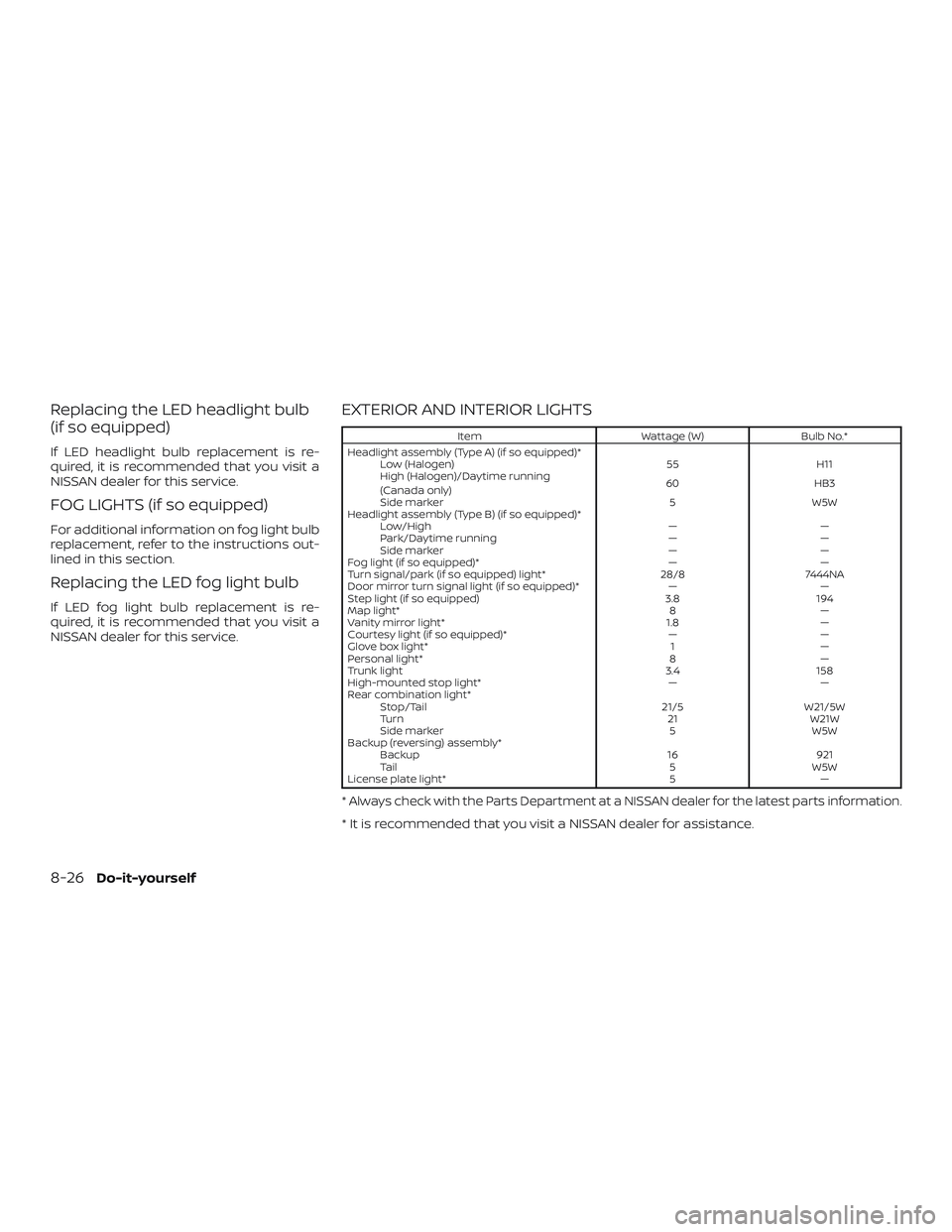
Replacing the LED headlight bulb
(if so equipped)
If LED headlight bulb replacement is re-
quired, it is recommended that you visit a
NISSAN dealer for this service.
FOG LIGHTS (if so equipped)
For additional information on fog light bulb
replacement, refer to the instructions out-
lined in this section.
Replacing the LED fog light bulb
If LED fog light bulb replacement is re-
quired, it is recommended that you visit a
NISSAN dealer for this service.
EXTERIOR AND INTERIOR LIGHTS
ItemWattage (W)Bulb No.*
Headlight assembly (Type A) (if so equipped)* Low (Halogen) 55H11
High (Halogen)/Daytime running
(Canada only) 60
HB3
Side marker 5W5W
Headlight assembly (Type B) (if so equipped)* Low/High ——
Park/Daytime running ——
Side marker ——
Fog light (if so equipped)* ——
Turn signal/park (if so equipped) light* 28/87444NA
Door mirror turn signal light (if so equipped)* ——
Step light (if so equipped) 3.8194
Map light* 8—
Vanity mirror light* 1.8—
Courtesy light (if so equipped)* ——
Glove box light* 1—
Personal light* 8—
Trunk light 3.4158
High-mounted stop light* ——
Rear combination light* Stop/Tail 21/5W21/5W
Turn 21W21W
Side marker 5W5W
Backup (reversing) assembly* Backup 16921
Tail 5W5W
License plate light* 5—
* Always check with the Parts Department at a NISSAN dealer for the latest parts information.
* It is recommended that you visit a NISSAN dealer for assistance.
8-26Do-it-yourself
Page 546 of 559
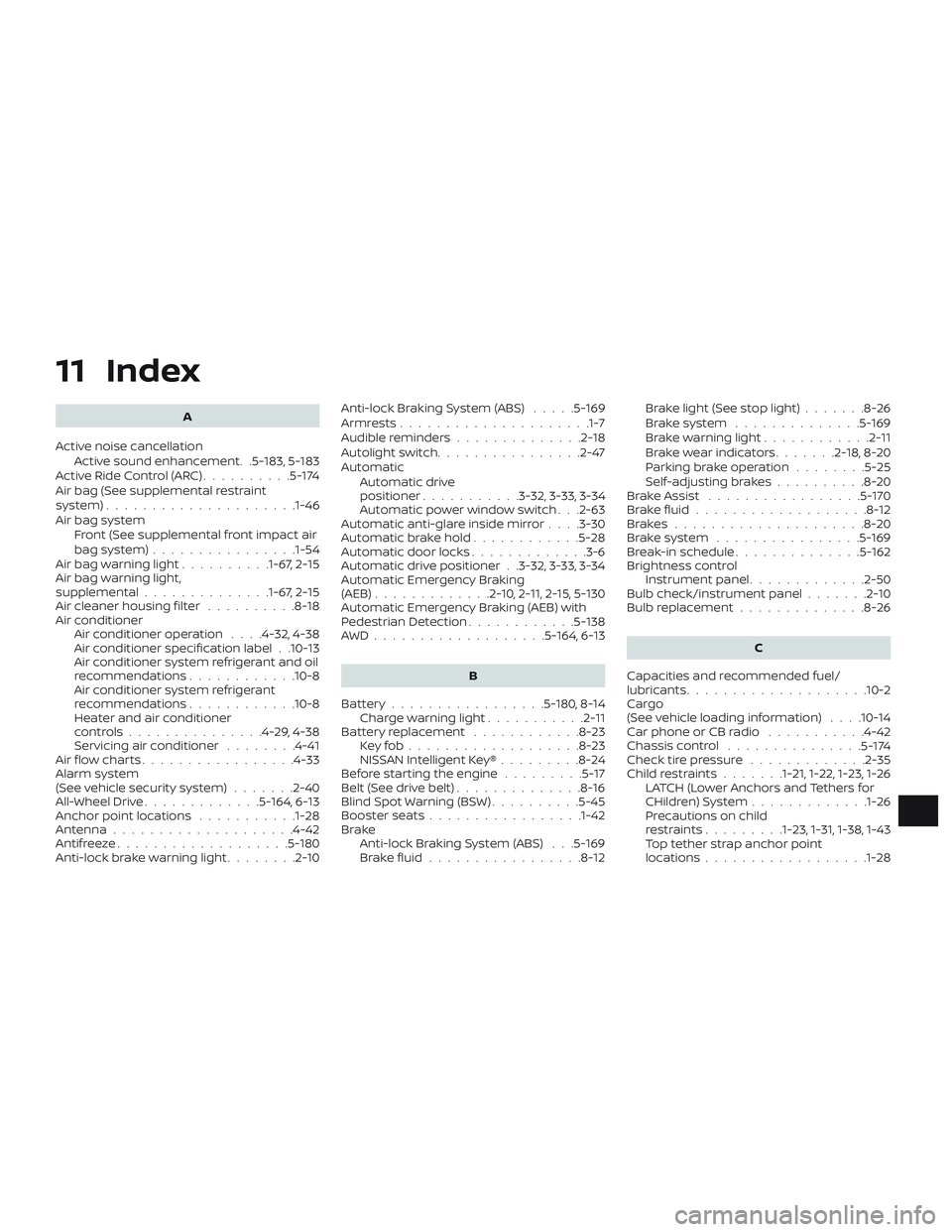
11 Index
A
Active noise cancellation Active sound enhancement. .5-183, 5-183
ActiveRideControl(ARC)..........5-174
Air bag (See supplemental restraint
system) .................... .1-46
Air bag system Front (See supplemental front impact air
bagsystem)............... .1-54
Airbagwarninglight..........1-67, 2-15
Air bag warning light,
supplemental ..............1-67, 2-15
Air cleaner housing filter ..........8-18
Air conditioner Air conditioner operation ....4-32,4-38
Air conditioner specification label . .10-13
Air conditioner system refrigerant and oil
recommendations ............10-8
Air conditioner system refrigerant
recommendations ............10-8
Heater and air conditioner
controls...............4-29,4-38
Servicing air conditioner ........4-41
Air flow charts .................4-33
Alarm system
(See vehicle security system) .......2-40
All-Wheel Drive .............5-164,6-13
Anchor point locations ...........1-28
Antenna ....................4-42
Antifreeze ...................5-180
Anti-lock brake warning light ........2-10Anti-lock Braking System (ABS)
.....5-169
Armrests.................... .1-7
Audible reminders ..............2-18
Autolightswitch................2-47
Automatic Automatic drive
positioner ...........3-32,3-33,3-34
Automatic power window switch . . .2-63
Automatic anti-glare inside mirror ....3-30
Automaticbrakehold............5-28
Automatic door locks .............3-6
Automatic drive positioner . .3-32, 3-33, 3-34
Automatic Emergency Braking
(AEB) .............2-10,2 -11, 2-15, 5-130
Automatic Emergency Braking (AEB) with
Pedestrian Detection ............5-138
AWD...................5-164,6-13
B
Battery.................5-180,8-14 Charge warning light ...........2-11
Battery replacement ............8-23
Keyfob...................8-23
NISSAN Intelligent Key® .........8-24
Before starting the engine .........5-17
Belt(Seedrivebelt)..............8-16
Blind Spot Warning (BSW) ..........5-45
Booster seats .................1-42
Brake Anti-lock Braking System (ABS) . . .5-169
Brakefluid.................8-12 Brakelight(Seestoplight).......8-26
Brakesystem ..............5-169
Brakewarninglight............2-11
Brakewearindicators.......2-18,8-20
Parking brake operation
........5-25
Self-adjustingbrakes..........8-20
Brake Assist .................5-170
Brakefluid...................8-12
Brakes.....................8-20
Brakesystem ................5-169
Break-in schedule ..............5 -162
Brightness control Instrument panel .............2-50
Bulb check/instrument panel .......2-10
Bulb replacement .............. 8-26
C
Capacities and recommended fuel/
lubricants....................10-2
Cargo
(See vehicle loading information) . . . .10-14
Car phone or CB radio ...........4-42
Chassis control ...............
5-174
Check tire pressure .............2-35
Childrestraints.......1-21, 1-22, 1-23, 1-26 LATCH (Lower Anchors and Tethers for
CHildren)System.............1-26
Precautions on child
restraints.........1-23, 1-31, 1-38, 1-43
Top tether strap anchor point
locations..................1-28
Page 550 of 559

O
Octane rating (See fuel octane rating) . .10-6
Odometer ....................2-5
Oil Capacities and recommended
fuel/lubricants...............10-2
Changing engine oil ............8-8
Changing engine oil filter .........8-8
Checking engine oil level .........8-7
Engine oil ...................8-7
Engine oil and oil filter
recommendation .............10-7
Engine oil viscosity .............10-7
Outsidemirrors.................3-31
Overhead sunglasses holder ........2-59
Overheat Ifyourvehicleoverheats.........6-11
Owner's manual order form ........10-23
Owner's manual/service manual order
information..................10-23
P
Parking Parking brake operation .........5-25
Parking/parkingonhills.........5-168
Parkingbrake...........2-12,2-16,5-25
Personal lights .................2-67
Power Power door locks ..............3-6
Poweroutlet................2-56
Powerrearwindows...........2-63
Power steering system .........5-168
Powerwindows ..............2-61 Rearpowerwindows...........2-63
Poweroutlet..................2-56
Powersteering................5-168
Precautions Maintenance precautions .........8-2
Precautions on booster
seats............1-23, 1-31, 1-38, 1-43
Precautions on child
restraints .........1-23, 1-31, 1-38, 1-43
Precautions on seat belt usage .....1-12
Precautions on supplemental restraint
system ................... .1-46
Precautions when starting and
driving..................5-4,5-11
ProPILOT Assist ................5-90
Push starting ..................6-11
R
Radio Car phone or CB radio ..........4-42
Readiness for inspection maintenance (I/M)
test .......................10-21
Rear Automatic Braking (RAB) .......5-124
RearCrossTrafficAlert(RCTA) .......5-55
Rear Door Alert .............2-37,2-55
Rearpowerwindows.............2-63
Rearseat.................... .1-5
Rear Sonar System (RSS) ..........5-175
Rearviewmirror................3-30
RearViewMonitor................4-3
Rear window and outside mirror defroster
switch......................2-44
Recommended Fluids ............10-2 Recorders
EventData.............10-21,10-22
Refrigerant recommendation ........10-8
Registering a vehicle in another
country .....................10-11
Remote Engine Start ..........3-19,5-18
Reporting safety defects (US only) . . . .10-20
S
Safety Child safety rear door lock ........3-7
Childseatbelts......1-23, 1-31, 1-38, 1-43
Reporting safety defects (US only) . .10-20
Seat adjustment Front manual seat adjustment ......1-3
Front power seat adjustment ......1-4
Rear seat adjustment ...........1-5
Seatback pockets ...............
2-58
Seat belt Childsafety ................ .1-21
Infants and small children ........1-22
InjuredPerson............... .1-15
Largerchildren.............. .1-22
Precautionsonseatbeltusage.....1-12
Pregnant women ..............1-15
Seat belt extenders ............1-20
Seat belt maintenance ..........1-20
Seatbelts................1-12, 7-7
Shoulder belt height adjustment . . . .1-19
Three-pointtypewithretractor.....1-15
Seat belt extenders ..............1-20
Seatbeltwarninglight.........1-14, 2-15
Seats Adjustment ..................1-2
11-5
Page 551 of 559

Armrests ...................1-7Automatic drive positioner. .3-32, 3-33, 3-34
Frontseats..................1-2
Manual front seat adjustment ......1-3
Rearseat...................1-5
Security indicator light ............2-17
Security system (NISSAN Vehicle Immobilizer
System), engine start ..........2-42,5-16
Security systems Vehicle security system .........2-40
Self-adjustingbrakes.............8-20
Service manual order form .........10-23
Servicing air conditioner ...........4-41
Shif ting Continuously Variable Transmission
(CVT) .....................5-21
Shiftleverlockrelease............5-23
Shoulder belt height adjustment ......1-19
Sonar Rear system ................5-175
Spark plug replacement ...........8-17
Spark plugs ...................8-17
Specifications ..................10-9
Speedometer ................2-4,2-5
Speedometer and odometer ........2-4
Spotlights(Seemaplight)..........2-66
SRS warning label ...............1-67
Stability control ................5-171
Standard maintenance . .9-10, 9-11, 9-14, 9-15
Starting Before starting the engine ........5-17
Jumpstarting.............6-9,8-15
Precautions when starting and
driving ..................5-4,5-11
Push starting ................6-11
Starting the engine ............5-17 Starting the engine
..............5-17
Steering Heated steering wheel ..........2-53
Powersteeringsystem.........5-168
Steering Assist switch
(forvehicleswithProPILOTAssist).....2-54
Steering wheel .................3-28
Stoplight....................8-26
Storage.....................2-58
Sunglasses case ................2-59
Sunglasses holder ..............2-59
Sunroof ......................7-5
Sunroof (see Moonroof ) ...........2-64
Sunvisors....................3-29
Supplemental air bag warning
light.................... .1-67, 2-15
Supplemental front impact air bag
system ..................... .1-54
Supplemental restraint system Information and warning labels . . . .1-67
Precautions on supplemental restraint
system ................... .1-46
Supplemental restraint system
(Supplemental air bag system) .......1-46
Switch Autolightswitch..............2-47
Automatic power window switch . . .2-63
Foglightswitch ..............2-51
Hazard warning flasher switch ......6-2
Headlight and turn signal switch ....2-45
Headlightcontrolswitch.........2-45
Instrument brightness control .....2-50
Power door lock switch ..........3-6
Rear window and outside mirror
defrosterswitch..............2-44
Turn signal switch .............2-50 T
Tachometer ...................2-6
Temperature gauge Engine coolant temperature gauge . .2-6
Thef t (NISSAN Vehicle Immobilizer System),
engine start ...............2-42,5-16
Three-waycatalyst...............5-4
Tilt T
elescopicsteering............3-28
Tire Flattire..................6-3,6-4
Spare tire ...............6-5,8-40
Tire and Loading Information label . .10-13
Tire chains .................8-36
Tire pressure ................8-29
Tirerotation.................8-37
Types of tires ................8-35
Uniform tire quality grading ......10-18
Wheels and tires ..............8-29
Wheel/tire size ...............10-10
Tire pressure Low tire pressure warning light .....2-12
Tire Pressure Monitoring System
(TPMS)....................5-5,6-3
Towing 4-wheel drive models ...........6-14
Flattowing.................10-18
Trailertowing...............10-18
Towingatrailer................10-18
Towingyourvehicle..............6-12
Traffic Sign Recognition (TSR) ........5-31
Transceiver HomeLink® Universal Transceiver . . .2-67, 2-68, 2-69, 2-70, 2-70, 2-71
11-6